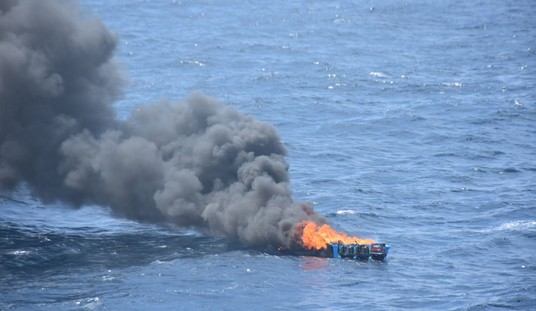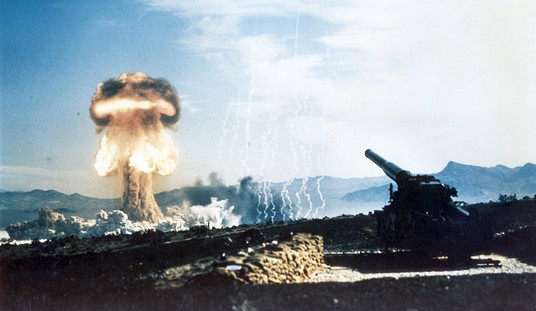A few years back, comedian Tina Fey did a bit on "Saturday Night Live" lampooning Alaska's former Governor Sarah Palin, in which she gushed, "I can see Russia from my house!" (I have it on good authority that Sarah Palin took that jibe in good humor.) Mrs. Palin's house is in Wasilla, where, of course, you can't see any part of Russia. Despite that, there are still ill-informed Democrats out there who think that Mrs. Palin actually said that, which is kind of pathetic, but there you are.
There is, however, a place in Alaska where you can see Russia. In the winter, when the Bering Strait is normally covered in sea ice, you can sometimes even walk from Russia to America, and vice versa. That place in Alaska is Little Diomede Island, and its Russian counterpart is Big Diomede Island. There is a long and interesting history between the two.
The people living on Little Diomede Island really can see Russia from their houses.
Even after Alaska became part of the United States, many cultural and familial ties lingered across the divide, and today, travellers to Alaska may still spot onion-domed Russian Orthodox churches, meet residents with Russian surnames and see Russian artefacts in museums. But nowhere is this cultural and geographical proximity more striking than on the Diomede Islands.
The Diomedes are two wind-lashed volcanic outcrops separated by just 2.4 miles of sea and ice. The smaller of the two, Little Diomede, is part of the US, while the larger, Big Diomede, is Russian.
As noted, 2.4 miles separate the two islands; in clear weather, easily within visual range. We should note that all across the Great Land, there are still remnants of the time span in which Alaska was "Russian America," not least of which are the local Russian Orthodox churches that still survive, and the many Russian-based place names, from Sitka to Kalifornsky; we live in the Matanuska-Susitna Borough, wherein the "Matanuska" is derived from the Russian, while "Susitna" is a Dena'ina (Alaska Native) word meaning "sandy river," which certainly applies. Alaska is replete with terms like this.
Nowhere is this more apparent than in the Diomedes, two windswept rocks in the expanses of the Bering Sea. In Friday's press briefing, Russian President Vladimir Putin referred to the International Date Line that separates American Alaska from Russian Siberia, noting that across that line one may "step from today into tomorrow," which was no doubt a planned metaphor. But in the Diomedes, at least in winter, one can do just that.
Yet, it isn't just countries and continents that cleave the twin isles: the invisible sweep of the International Date Line also runs between them. So, despite the fact that residents on Little Diomede can see Russia from their wooden cabins and – in theory – walk across the frozen ice bridge to Big Diomede, as their ancestors did, Big Diomede is 21 hours ahead of Little Diomede, a quirk that has led locals to dub the frozen outcrops the "Yesterday and Tomorrow Islands".
Today, Big Diomede is uninhabited, save for a Russian border guard station. Little Diomede is home to about 80 residents – most of them Iñupiat, who live in a cluster of houses perched on the western shore, the only patch of relatively flat ground between sheer cliffs and the turbulent sea. Helicopters usually deliver mail and a few supplies once per week, but fog and violent winds often delay landings for days or weeks on end. Instead, residents on Little Diomede have relied on fishing, hunting seals and walrus and catching seabirds for centuries.
The people of Little Diomede are, today, doing much as they have been for centuries: Relying on fishing, sealing, and nesting seabirds for food. The tiny village on that frozen shore appears to be, today, mostly prefabricated structures. There is a school, and a local government; the islands are also part of Alaska's Nome Census Area and the Unorganized Borough. The town has a laundromat, a small Catholic Church, and a library. Electricity is provided by diesel generators, and internet access as well as television is by satellite.
In 1867, when Alaska was purchased by the United States and the territorial line was drawn between Big and Little Diomede, the people of those islands took little notice, carrying on as they had, with trade between the two islands. In summer, they paddled back and forth; in winter, they walked or even dog-sledded across that 2.4-mile gap. Families were spread between the islands, and marriages took place, giving rise to families with members from both islands.
In 1948, the Soviet Union ended all that by forcibly relocating all of Big Diomede's native population to the mainland. The border was sealed - as much as 2.4 miles of open water and sea ice can be - and the "Ice Curtain" drawn between the two islands. Many on Little Diomede still have relatives among the former residents of Big Diomede and their descendants, now scattered across Russian Siberia.
Things have improved somewhat since. While the only human presence on Big Diomede is a Russian border station, in 1988, a chartered Alaska Airlines airliner took some politicians (who probably weren't needed) and some Alaska Natives from Little Diomede (who were) to the Soviet Union, where some family members were happily reunited. That led to a slight thawing (hah) of relations between people in that area on both sides of the border.
That lasted until Vladimir Putin came to power in Russia.
Read More: Watch: Putin's Reaction to Trump’s Incredible Military Flex in Alaska
Trump Arriving in Alaska Friday for Meet-Up With Putin, and the Local Left Has Big Plans
Today, in the school on Little Diomede, there is still a mural, depicting two hands joined across the ocean, with the word "friend" written in English and Russian. But the natives living on Little Diomede today are casting a wary eye across that 2.4 miles of water at the Russian island, and reporting to the American Department of Defense about ever-increasing Russian naval and air activity in the region.
In the coming years, the Arctic will become an ever-more important strategic area, and Alaska, situated at the northern edge of the Pacific and serving as America's primary gateway to the Arctic, will remain as General Billy Mitchell described it in 1935 - as the most strategic real estate on the planet. The people of Little Diomede, though, will probably continue as they are, as the only Americans who really can see Russia from their house.















